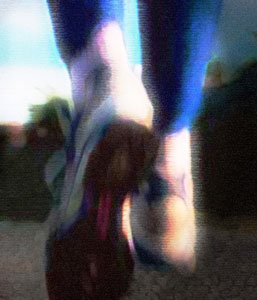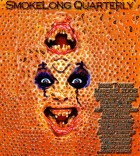There she is, dancing around in her running tights on the corner of Fillmore and Fulton. I can see her aquamarine blue spandex legs hopping behind the stem of a stoplight. She is impatient. We have a standing date at 6:30 every morning, and I am always late. When I get closer her hair comes into focus, pulled back in a blond ponytail, and then her face. She squints at me and then her features settle into recognition. Hurry, her body says.
We take off down Fillmore. The early morning sidewalk is blown over with bits of trash. Crumpled sandwich wrappers from the McDonald’s turn over in the slight wind. Mist freezes over the skin on my calves, causing hard goosebumps to rise.
We are talking about alcoholics. In a general sort of way. Her sister has just been let out of rehab, at 19. She’s worried for the rest of her life. She keeps repeating that phrase, the rest of her life. I try not to talk about alcoholics, or at least any specific ones. I don’t have the energy for it today. It’s enough to be feeling the muscle in my thighs ignite. I can handle small foci of pain. The sun is a small orb just bumping over the eastern side of the bay. It won’t crack open the sky until we are done with each other for the morning, sweating out goodbyes back at the intersection.
The thing is, she says, as we rise up the hill into Pacific Heights, it’s a stigma she’ll carry. Don’t you agree? I kind of bite my lip. The trash has receded with our ascent into the wealthier neighborhood. Not necessarily, I say back, my voice flat, plain. It’s not like they come with a sign on their forehead. It’s not like the violence is evident. But she isn’t thinking about anger. The sister has never thrown anything, or punched anyone, or split her personality in two. That might come later, I think but don’t say. The sister ruined herself at parties, poisoned herself into the hospital, sucked herself dry and tired in a matter of months. Now my friend is worried about relapse. She is worried about her sister getting back into college. She is wondering what will become of the rest of her life.
We turn a left down Broadway, and a right at Steiner. We stop to admire the same house every day, dark gray stone with ivy climbing up the sides. A molded face looks out from one of the walls, about the size of a real human head. Like the theater masks of comedy and tragedy, its cheeks are sculpted and its eye sockets realistic. Unlike the masks, it wears a strange expression: the eyes are neutral, difficult, and the lips puff out, spitting two identical streams of water from the corners of the mouth. The streams arc and are caught neatly into small metal basins positioned on each side underneath the head. We guess the water is recycled and spit back out again. We stop and jog in place, staring up at the head. It’s getting lighter out and my goosebumps have gone away. The slate blue bay is in the corner of my eye. We watch the head silently for a few moments, spitting endlessly. I wonder if we are thinking the same things. Don’t try to understand it, I want to say. Instead we turn, at the same time, silently, and keep running towards the bay.



 The core workshop of SmokeLong Fitness is all in writing, so you can take part from anywhere at anytime. We are excited about creating a supportive, consistent and structured environment for flash writers to work on their craft in a community. We are thrilled and proud to say that our workshop participants have won, placed, or been listed in every major flash competition. Community works.
The core workshop of SmokeLong Fitness is all in writing, so you can take part from anywhere at anytime. We are excited about creating a supportive, consistent and structured environment for flash writers to work on their craft in a community. We are thrilled and proud to say that our workshop participants have won, placed, or been listed in every major flash competition. Community works.